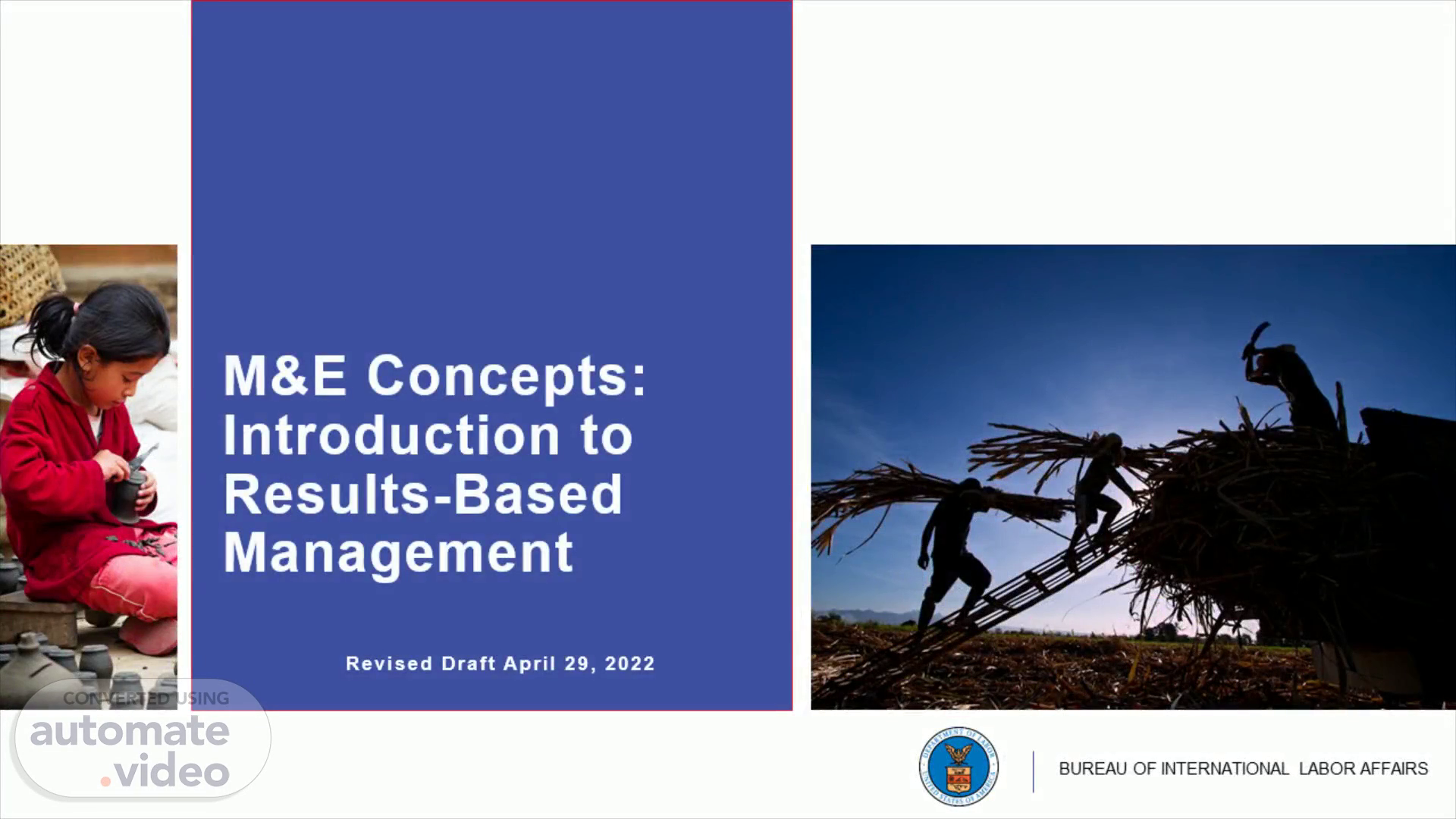
M&E Concepts: Introduction to Results-Based Management
Scene 1 (0s)
[Audio] %[ break]% I am _____ and I will be co-facilitating this training today along with my colleague _________ ( Trainers introduce themselves).
Scene 2 (13s)
[Audio] This is the first of six courses of the ILAB/ DOL Grantee M&E Concepts Series. These courses are designed to help grantees learn and understand the key monitoring and evaluation ( M&E) concepts that ILAB/DOL uses to guide project reporting and decisions. These courses should help guide the development of your Comprehensive Monitoring and Evaluation Plan ( CMEP) as well as the projects data collection and reporting. Today this course will be focusing on an introduction to results-based management. Following this course, the additional available courses will cover: Designing results frameworks, Designing and defining performance indicators, Developing data collection tools Setting baseline values and indicator targets Using data for project improvement..
Scene 3 (1m 12s)
[Audio] The objectives for today's training are to increase participants understanding of the key components of results-based management ( RBM). And increase their understanding of the purpose and core components of ILAB/ DOL's Comprehensive Monitoring and Evaluation Plan ( CMEP)..
Scene 4 (1m 32s)
[Audio] Today's course will be about 65 minutes long and cover the following topics: Introduction to results-based management ( RBM) Review the RBM steps Discuss how to use RBM Overview of Comprehensive Monitoring and Evaluation Plan ( CMEP) Summary.
Scene 5 (1m 57s)
[Audio] To start this session, we will provide a general Introduction to Results Based Management ( RBM).
Scene 6 (2m 5s)
[Audio] Results Based Management ( RBM) is a management approach that brings results to the center of the planning and decision-making process. RBM focus on results, instead of only on project activities to encourage learning and adapting throughout a life of a project. RBM lays out a process and a set of tools that helps project monitor and manage the implementation of their strategy. This includes the development of a theory of change, indicators and performance monitoring plan ( PMP), all of which we will explain in more detail throughout this session. The RBM system helps provide evidence through the collection of data that is aligned with the project strategy to inform decision making..
Scene 7 (2m 52s)
[Audio] There are many benefits to using RBM. Some of the key benefits include: Planning Process: Focuses on results and the cause-and-effect linkage Building consensus and ownership: Creates shared understanding through documented strategy and plan on how success is measures and achieved Communication: Convey project intent and content to internal and external stakeholders Management and reporting: Standardized and regular data outputs for monitoring to track progress towards results to inform decision making.
Scene 8 (3m 35s)
[Audio] Results based management provides a planning framework that facilitates focused planning on project results from the design phase. This process allows you to align project activities with the desired results to ensure that they will be supported through programming and can be achieved. RBM also uses the cause-and-effect linkages between the activities and results to guide the development of a feasible and measurable strategy..
Scene 9 (4m 3s)
[Audio] RBM creates a shared understanding through a documented strategy and plan on how success is to be achieved and measured. The tools outline the specific results, indicators, activities and roles of partners which can be used to build census and ownership within the project as well as with DOL and external stakeholders..
Scene 10 (4m 25s)
[Audio] RBM also supports effective and efficient communication through the use of key tools (e.g., results framework and indicators) which conveys project's intent and content to internal and external stakeholders. The use of these tools provide important information and data which can be used for communications within the project and externally..
Scene 11 (4m 48s)
[Audio] RBM also improves understanding of progress within the context of the strategy by tracking progress towards each result to inform decision making. It allows for evidence-based adjustments to implementation or strategy, as necessary through the regular standardized collection and reporting of data that is aligned with the strategy..
Scene 12 (5m 11s)
[Audio] RBM uses a six step process. These include: Defining results (e.g., developing a results frameworks) Selecting Performance indicators Developing a Performance monitoring plan ( PMP) Collecting Performance data Analyzing Performance data Using analysis to inform management decisions One of the key parts of the RBM process is the feedback loop. Any learning and decisions from step 6 should be incorporated and used to revisit and refine (if needed) the project results ( strategy), indicators and overall approach. This process along with each of the steps will be explained in more detail in the next set of slides. We will now talk about each of these steps in a little more detail..
Scene 13 (6m 9s)
[Audio] The first step of the RBM system is to define the results. This step is where the project strategy is developed. This is one of the most important and key elements of any M&E system, since it provides an overall framework to structure the system on. This includes defining the highest-level result – the project objective and developing the overall theory of change for the project. This theory of change is often represented in the form of a visual results framework and a narrative. The theory of change is the thinking behind how a particular intervention/project will bring about results. Projects should contain definite ideas about causal relationships. The theory of change is a set of results that outlines the if/then logic behind how a particular intervention / project will bring about a change or results. Causal logic is based on if…then thinking / If A, then B. for example: IF we vaccinate children, THEN there will be fewer deaths.